Preparation, Mechanical Properties, and Degradation Behavior of Zn-1Fe-xSr Alloys for Biomedical Applications
Abstract
1. Introduction
2. Materials and Methods
2.1. Materials
2.2. Microstructure Characterization
2.3. Mechanical Property Test
2.4. Immersion Test
2.5. Electrochemical Test
3. Results and Discussion
3.1. Microstructure
3.2. Mechanical Properties
3.2.1. Brinell Hardness
3.2.2. Tensile Properties
3.3. Degradation Properties
3.3.1. Electrochemical Behavior
3.3.2. Immersion Test
4. Conclusions
- (1)
- The irregular blocky SrZn13 phase was generated in the η-Zn matrix when the Sr element was added. With the increase in Sr addition, the grain size of the Zn-1Fe-xSr alloy decreased, and the amount of SrZn13 phase increased;
- (2)
- The UTS and Brinell hardness of Zn-1Fe-xSr alloy were enhanced significantly by the addition of Sr element. With the increase in Sr addition, the UTS and hardness increased. The UTS and hardness of Zn-1Fe-2Sr alloy were 141.65 MPa and 87.69 HBW, which were 55.7% and 58.4% higher than those of Zn-1Fe alloy, respectively;
- (3)
- As the Sr content increased, the corrosion current density of Zn-1Fe-xSr alloy increased, and the charge transfer resistance decreased significantly, indicating that the increased degradation rate. Zn-1Fe-2Sr alloy had a degradation rate of 0.157 mg·cm−2·d−1, which was 118.1% higher than the degradation rate of Zn-1Fe alloy;
- (4)
- With the increase in immersion time, the degradation rate of Zn-1Fe-xSr alloy decreased significantly. This was mainly due to the generation of a degradation product film on the alloy, which served as a protective layer, leading to a decrease in degradation rate.
Author Contributions
Funding
Institutional Review Board Statement
Informed Consent Statement
Data Availability Statement
Conflicts of Interest
References
- Zaman, H.A.; Sharif, S.; Idris, M.H.; Kamarudin, A. Metallic biomaterials for medical implant applications: A review. AMM 2015, 735, 19–25. [Google Scholar] [CrossRef]
- Xu, J.; Bao, G.; Jia, B.; Wang, M.; Wen, P.; Kan, T.; Zhang, S.; Liu, A.; Tang, H.; Yang, H. An adaptive biodegradable zinc alloy with bidirectional regulation of bone homeostasis for treating fractures and aged bone defects. Bioact. Mater. 2024, 38, 207–224. [Google Scholar] [CrossRef]
- Moravej, M.; Mantovani, D. Biodegradable metals for cardiovascular stent application: Interests and new opportunities. Int. J. Mol. Sci. 2011, 12, 4250–4270. [Google Scholar] [CrossRef]
- Tsakiris, V.; Tardei, C.; Clicinschi, F.M. Biodegradable Mg alloys for orthopedic implants—A review. J. Magnes. Alloys 2021, 9, 1884–1905. [Google Scholar] [CrossRef]
- Young, J.; Reddy, R.G. Synthesis, mechanical properties, and in vitro corrosion behavior of biodegradable Zn-Li-Cu alloys. J. Alloys Compd. 2020, 844, 156257. [Google Scholar] [CrossRef]
- Guo, B.; Ma, P.X. Synthetic biodegradable functional polymers for tissue engineering: A brief review. Sci. China Chem. 2014, 57, 490–500. [Google Scholar] [CrossRef] [PubMed]
- Alizadeh-Osgouei, M.; Li, Y.; Wen, C. A comprehensive review of biodegradable synthetic polymer-ceramic composites and their manufacture for biomedical applications. Bioact. Mater. 2019, 4, 22–36. [Google Scholar] [CrossRef]
- Li, X.; Cui, R.; Sun, L.; Aifantis, K.E.; Fan, B.; Feng, Q.; Cui, F. 3D-printed biopolymers for tissue engineering application. Int. J. Polym. 2014, 2014, 1–13. [Google Scholar] [CrossRef]
- Sekar, P.; Narendranath, S.; Desai, V. Recent progress in in vivo studies and clinical applications of magnesium based biodegradable implants—A review. J. Magnes. Alloys 2021, 9, 1147–1163. [Google Scholar] [CrossRef]
- Schinhammer, M.; Hänzi, A.C.; Löffler, J.F.; Uggowitzer, P.J. Design strategy for biodegradable Fe-based alloys for medical applications. Acta Biomater. 2010, 6, 1705–1713. [Google Scholar] [CrossRef]
- Zhuo, X.; Wu, Y.; Ju, J.; Liu, H.; Jiang, J.; Hu, Z.; Bai, J.; Xue, F. Recent progress of novel biodegradable zinc alloys: From the perspective of strengthening and toughening. J. Mater. Res. Technol. 2022, 17, 244–269. [Google Scholar] [CrossRef]
- Su, J.; Teng, J.; Xu, Z.; Li, Y. Biodegradable magnesium-matrix composites: A review. Int. J. Miner. Metall. Mater. 2020, 27, 724–744. [Google Scholar] [CrossRef]
- Tong, X.; Shen, T.; Zhou, X.; Zeng, J.; Tao, J.; Munir, K.; Li, Y.; Huang, S.; Wu, X.; Ma, J. Biodegradable Zn-Cu-Li alloys with ultrahigh strength, ductility, antibacterial ability, cytocompatibility, and suitable degradation rate for potential bone-implant applications. Smart Mater. Manuf. 2023, 1, 100012. [Google Scholar] [CrossRef]
- Lin, J.; Tong, X.; Sun, Q.; Luan, Y.; Zhang, D.; Shi, Z.; Wang, K.; Lin, J.; Li, Y.; Dargusch, M. Biodegradable ternary Zn-3Ge-0.5X (X = Cu, Mg, and Fe) alloys for orthopedic applications. Acta Biomater. 2020, 115, 432–446. [Google Scholar] [CrossRef] [PubMed]
- Xiao, X.; Liu, E.; Shao, J.; Ge, S. Advances on biodegradable zinc-silver-based alloys for biomedical applications. J. Appl. Biomater. Funct. Mater. 2021, 19, 228080002110624. [Google Scholar] [CrossRef] [PubMed]
- Lin, J.; Tong, X.; Wang, K.; Shi, Z.; Li, Y.; Dargusch, M.; Wen, C. Biodegradable Zn-3Cu and Zn-3Cu-0.2Ti alloys with ultrahigh ductility and antibacterial ability for orthopedic applications. J. Mater. Sci. Technol. 2021, 68, 76–90. [Google Scholar] [CrossRef]
- Tong, X.; Han, Y.; Zhou, R.; Jiang, W.; Zhu, L.; Li, Y.; Huang, S.; Ma, J.; Wen, C.; Lin, J. Biodegradable Zn-Dy binary alloys with high strength, ductility, cytocompatibility, and antibacterial ability for bone-implant applications. Acta Biomater. 2023, 155, 684–702. [Google Scholar] [CrossRef]
- Školáková, A.; Pinc, J.; Jablonská, E.; Školáková, T.; Veřtát, P.; Janebová, B.; Kutová, A.; Čapek, J.; Hosová, K.; Vojtěch, D. A zinc phosphate layered biodegradable Zn-0.8Mg-0.2Sr alloy: Characterization and mechanism of hopeite formation. Surf. Coat. Technol. 2024, 487, 130986. [Google Scholar] [CrossRef]
- Mostaed, E.; Sikora-Jasinska, M.; Drelich, J.W.; Vedani, M. Zinc-based alloys for degradable vascular stent applications. Acta Biomater. 2018, 71, 1–23. [Google Scholar] [CrossRef]
- Yan, Y.; Liu, H.; Fang, H.; Yu, K.; Zhang, T.; Xu, X.; Zhang, Y.; Dai, Y. Effects of the intermetallic phases on microstructure and properties of biodegradable magnesium matrix and zinc matrix prepared by powder metallurgy. Mater. Trans. 2018, 59, 1837–1844. [Google Scholar] [CrossRef]
- Qi, M.; Wei, L.; Xu, Y.; Wang, J.; Liu, A. Effect of trace yttrium on the microstructure, mechanical property and corrosion behavior of homogenized Mg-2Zn-0.1Mn-0.3Ca-xY biological magnesium alloy. Int. J. Miner. Metall. Mater. 2022, 29, 1746–1754. [Google Scholar] [CrossRef]
- Kamrani, S.; Fleck, C. Biodegradable magnesium alloys as temporary orthopaedic implants: A review. Biometals 2019, 32, 185–193. [Google Scholar] [CrossRef] [PubMed]
- Du, S.; Shen, Y.; Zheng, Y.; Cheng, Y.; Xu, X.; Chen, D.; Xia, D. Systematic in vitro and in vivo study on biodegradable binary Zn-0.2 at% rare earth alloys (Zn-RE: Sc, Y, La-Nd, Sm-Lu). Bioact. Mater. 2023, 24, 507–523. [Google Scholar] [CrossRef] [PubMed]
- Hambidge, K.M.; Krebs, N.F. Zinc deficiency: A special challenge. J. Nutr. 2007, 137, 1101–1105. [Google Scholar] [CrossRef] [PubMed]
- Khan, S.T.; Malik, A.; Alwarthan, A.; Shaik, M.R. The enormity of the zinc deficiency problem and available solutions; an overview. Arab. J. Chem. 2022, 15, 103668. [Google Scholar] [CrossRef]
- Hou, Y.; Jia, G.; Yue, R.; Chen, C.; Pei, J.; Zhang, H.; Huang, H.; Xiong, M.; Yuan, G. Synthesis of biodegradable Zn-based scaffolds using NaCl templates: Relationship between porosity, compressive properties and degradation behavior. Mater. Charact. 2018, 137, 162–169. [Google Scholar] [CrossRef]
- Shishir, R.; Nasiruddin, U.; Manojkumar, P.; Lokeshkumar, E.; Ponnilavan, V.; Parfenov, E.V.; Valiev, R.Z.; Rameshbabu, N. Zinc as a potential bio-degradable temporary implant material. Mater. Today Proc. 2023, S2214785323046680. [Google Scholar] [CrossRef]
- Chen, K.; Gu, X.; Zheng, Y. Feasibility, challenges and future prospects of biodegradable zinc alloys as orthopedic internal fixation implants. Smart Mater. Manuf. 2024, 2, 100042. [Google Scholar] [CrossRef]
- Xiao, X.; Wang, B.; Liu, E.; Liu, H.; Liu, L.; Xu, W.; Ge, S.; Shao, J. Investigation of zinc-silver alloys as biodegradable metals for orthopedic applications. J. Mater. Res. Technol. 2023, 26, 6287–6303. [Google Scholar] [CrossRef]
- Venezuela, J.; Dargusch, M.S. The influence of alloying and fabrication techniques on the mechanical properties, biodegradability and biocompatibility of zinc: A comprehensive review. Acta Biomater. 2019, 87, 1–40. [Google Scholar] [CrossRef]
- Lieu, P.T.; Heiskala, M.; Peterson, P.A.; Yang, Y. The roles of iron in health and disease. Mol. Asp. Med. 2001, 22, 1–87. [Google Scholar] [CrossRef] [PubMed]
- Zhang, W.; Li, P.; Shen, G.; Mo, X.; Zhou, C.; Alexander, D.; Rupp, F.; Geis-Gerstorfer, J.; Zhang, H.; Wan, G. Appropriately adapted properties of hot-extruded Zn-0.5Cu-xFe alloys aimed for biodegradable guided bone regeneration membrane application. Bioact. Mater. 2021, 6, 975–989. [Google Scholar] [CrossRef]
- Braux, J.; Velard, F.; Guillaume, C.; Bouthors, S.; Jallot, E.; Nedelec, J.-M.; Laurent-Maquin, D.; Laquerrière, P. A new insight into the dissociating effect of strontium on bone resorption and formation. Acta Biomater. 2011, 7, 2593–2603. [Google Scholar] [CrossRef] [PubMed]
- Liu, X.; Sun, J.; Qiu, K.; Yang, Y.; Pu, Z.; Li, L.; Zheng, Y. Effects of alloying elements (Ca and Sr) on microstructure, mechanical property and in vitro corrosion behavior of biodegradable Zn-1.5Mg alloy. J. Alloys Compd. 2016, 664, 444–452. [Google Scholar] [CrossRef]
- Qin, J.; Chang, L.; Su, X. Influence of Sr on microstructure evolution, mechanical and corrosion properties of extruded Mg-2Zn-0.5Ca alloy. J. Magnes. Alloys 2023, S2213956723000567. [Google Scholar] [CrossRef]
- Meng, X.; Jiang, Z.; Zhu, S.; Guan, S. Effects of Sr addition on microstructure, mechanical and corrosion properties of biodegradable Mg-Zn-Ca alloy. J. Alloys Compd. 2020, 838, 155611. [Google Scholar] [CrossRef]
- Gutiérrez-Menchaca, J.; Torres-Torres, D.; Garay-Tapia, A.M. Microstructural, mechanical and thermodynamic study of the as-cast Zn-Al-Sr alloys at high Sr content. J. Alloys Compd. 2020, 829, 154511. [Google Scholar] [CrossRef]
- Kabir, H.; Munir, K.; Wen, C.; Li, Y. Recent research and progress of biodegradable zinc alloys and composites for biomedical applications: Biomechanical and biocorrosion perspectives. Bioact. Mater. 2021, 6, 836–879. [Google Scholar] [CrossRef]
- Xiong, W.; Kong, Y.; Du, Y.; Liu, Z.-K.; Selleby, M.; Sun, W.-H. Thermodynamic investigation of the galvanizing systems, I: Refinement of the thermodynamic description for the Fe-Zn system. Calphad 2009, 33, 433–440. [Google Scholar] [CrossRef]
- Spencer, P.J.; Pelton, A.D.; Kang, Y.-B.; Chartrand, P.; Fuerst, C.D. Thermodynamic assessment of the Ca-Zn, Sr-Zn, Y-Zn and Ce-Zn systems. Calphad 2008, 32, 423–431. [Google Scholar] [CrossRef]
- Luqman, M.; Ali, Y.; Zaghloul, M.M.Y.; Sheikh, F.A.; Chan, V.; Abdal-hay, A. Grain refinement mechanism and its effect on mechanical properties and biodegradation behaviors of Zn alloys—A review. J. Mater. Res. Technol. 2023, 24, 7338–7365. [Google Scholar] [CrossRef]
- Zhu, W.; Jin, H.M.; Wu, P.; Liu, H.L. Periodic density functional theory study of the crystal morphology of FeZn13. Phys. Rev. B 2004, 70, 165419. [Google Scholar] [CrossRef]
- Ke, G.; Yue, R.; Huang, H.; Kang, B.; Zeng, H.; Yuan, G. Effects of Sr addition on microstructure, mechanical properties and in vitro degradation behavior of as-extruded Zn-Sr binary alloys. Trans. Nonferrous Met. Soc. China 2020, 30, 1873–1883. [Google Scholar] [CrossRef]
- Cui, X.; Yu, Z.; Liu, F.; Du, Z.; Bai, P. Influence of secondary phases on crack initiation and propagation during fracture process of as-cast Mg-Al-Zn-Nd alloy. Mater. Sci. Eng. A 2019, 759, 708–714. [Google Scholar] [CrossRef]
- Yang, Z.; Zhao, S.; Li, J.; Gao, Z.; Liu, D.; Xu, Y.; Guo, E. A novel biodegradable nanocrystalline Zn alloy with exceptional biocompatible and antibacterial properties. J. Mater. Res. Technol. 2024, 28, 3746–3758. [Google Scholar] [CrossRef]
- Zhang, M.; Liu, E.; Xiao, X.; Yu, S.; Li, H.; Wang, K.; Gong, P.; Li, W.; Song, Y.; Sun, D. Microstructure, mechanical properties and in vitro degradation properties of Zn-Fe alloys. Mater. Charact. 2022, 192, 112220. [Google Scholar] [CrossRef]
- Rosalbino, F.; Angelini, E.; Macciò, D.; Saccone, A.; Delfino, S. Application of EIS to assess the effect of rare earths small addition on the corrosion behaviour of Zn-5% Al (Galfan) alloy in neutral aerated sodium chloride solution. Electrochim. Acta 2009, 54, 1204–1209. [Google Scholar] [CrossRef]
- Xue, P.; Ma, M.; Li, Y.; Li, X.; Yuan, J.; Shi, G.; Wang, K.; Zhang, K. Microstructure, mechanical properties, and in vitro corrosion behavior of biodegradable Zn-1Fe-xMg alloy. Materials 2020, 13, 4835. [Google Scholar] [CrossRef]
- Li, Z.; Shi, Z.Z.; Yan, Y.; Zhang, D.; Yang, K.; Li, H.-F.; Zhang, H.; Wang, L.-N. Suppression mechanism of initial pitting corrosion of pure Zn by Li alloying. Corros. Sci. 2021, 189, 109564. [Google Scholar] [CrossRef]
- Liu, X.; Sun, J.; Zhou, F.; Yang, Y.; Chang, R.; Qiu, K.; Pu, Z.; Li, L.; Zheng, Y. Micro-alloying with Mn in Zn-Mg alloy for future biodegradable metals application. Mater. Des. 2016, 94, 95–104. [Google Scholar] [CrossRef]
- Lai, H.; Li, J.; Li, J.; Zhang, Y.; Xu, Y. Effects of Sr on the microstructure, mechanical properties and corrosion behavior of Mg-2Zn-xSr alloys. J. Mater. Sci. Mater. Med. 2018, 29, 87. [Google Scholar] [CrossRef]
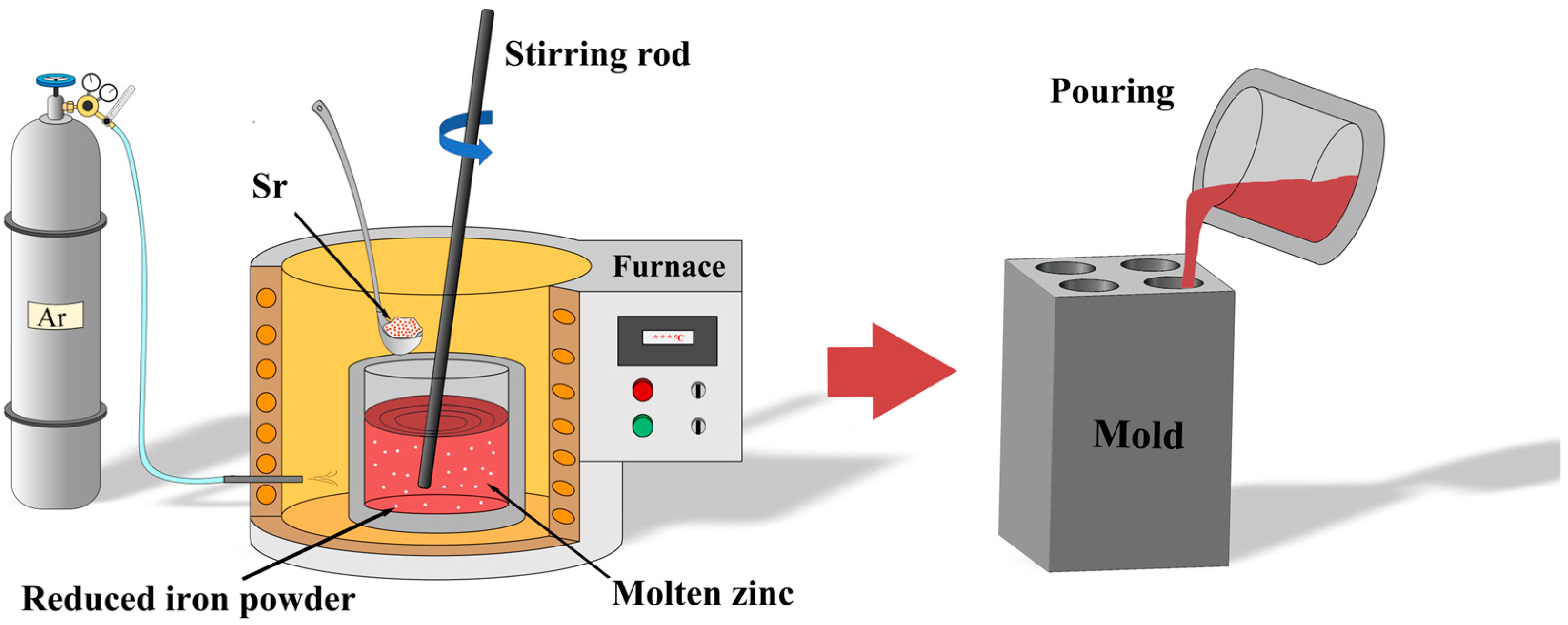
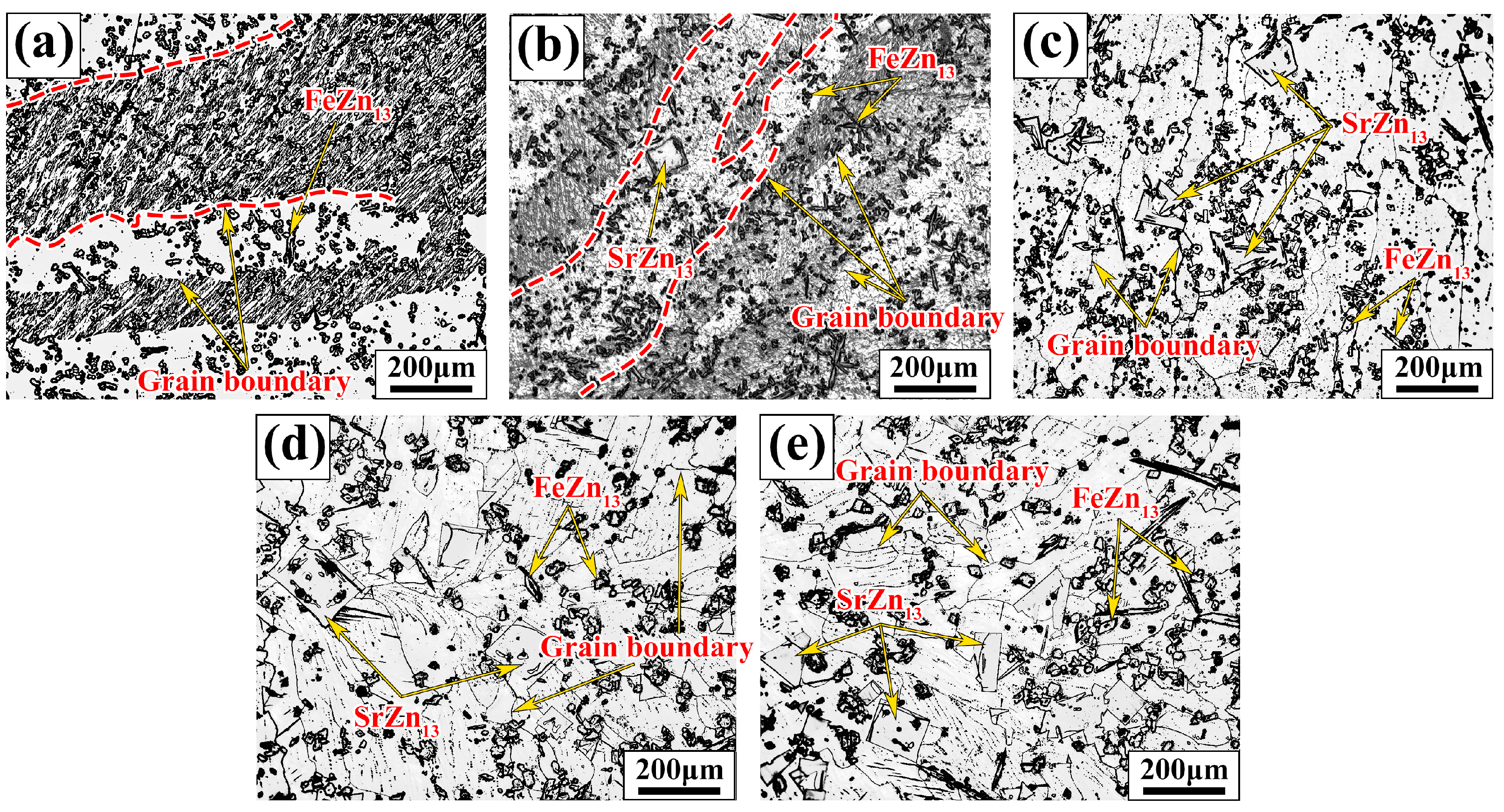


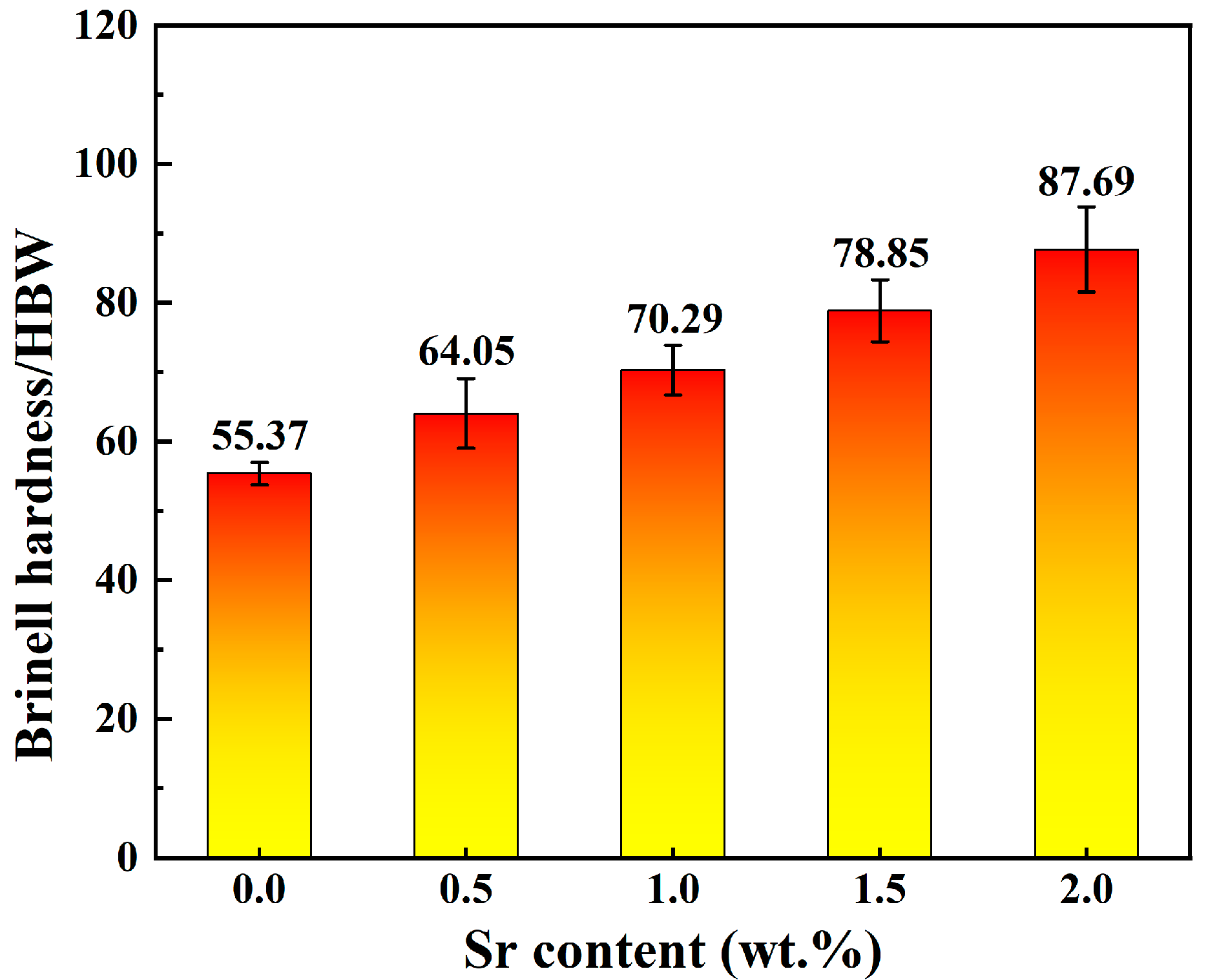
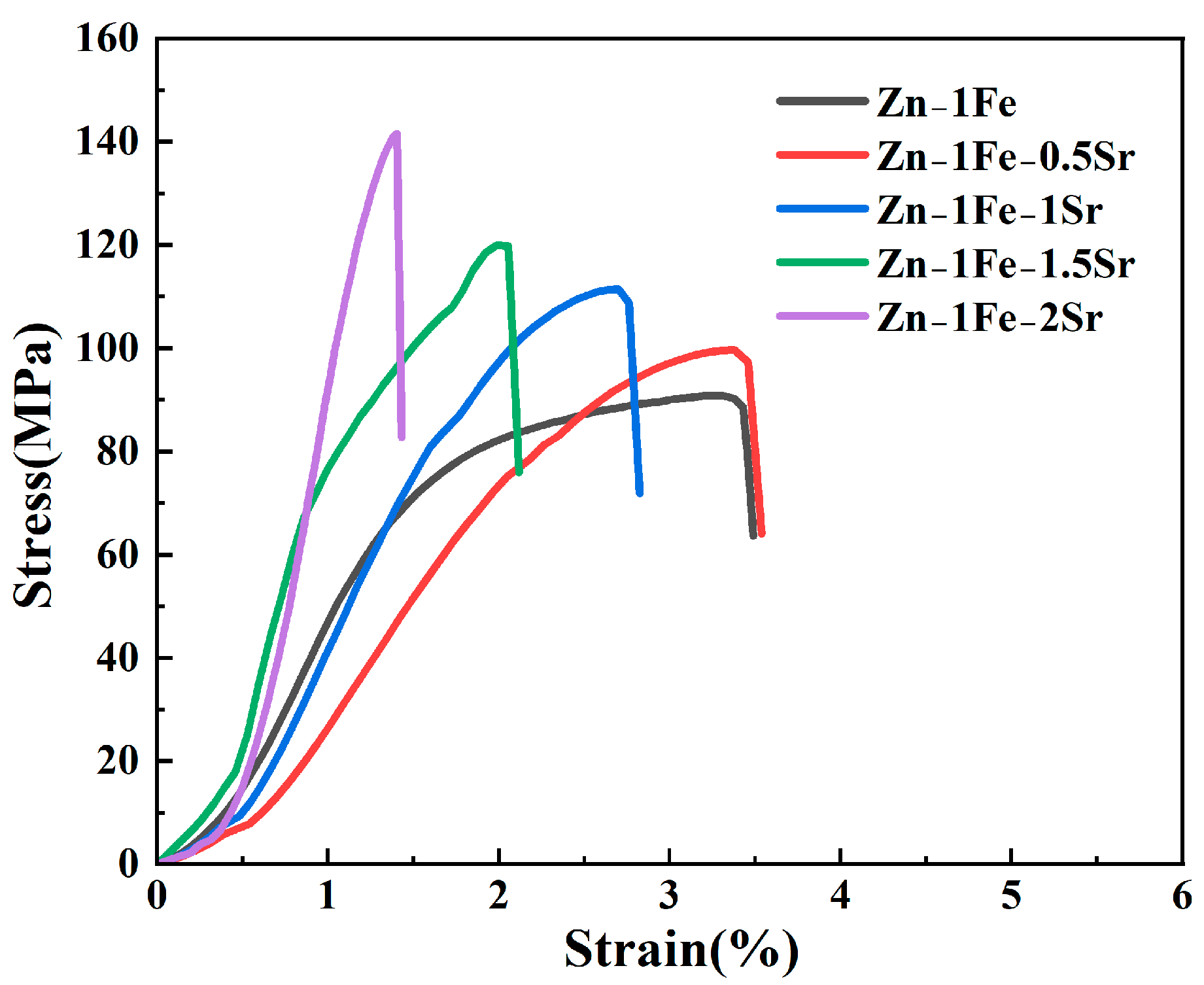



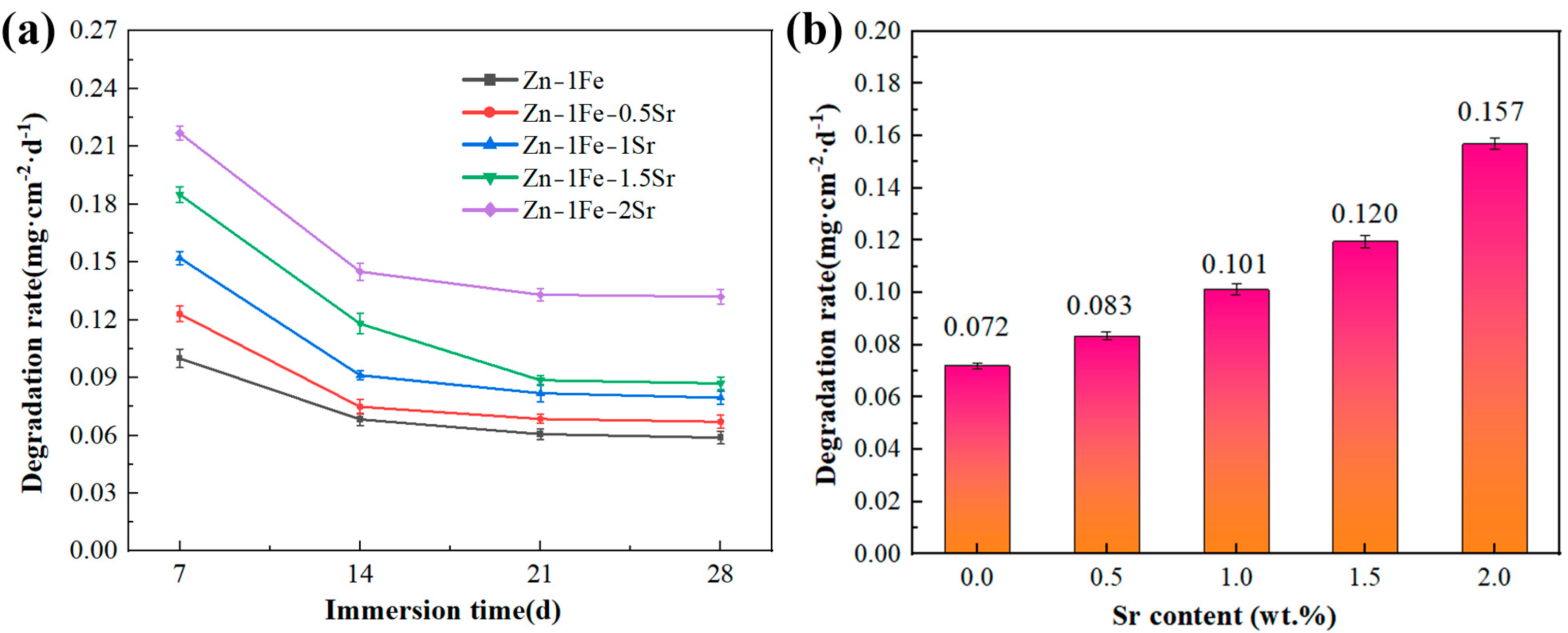
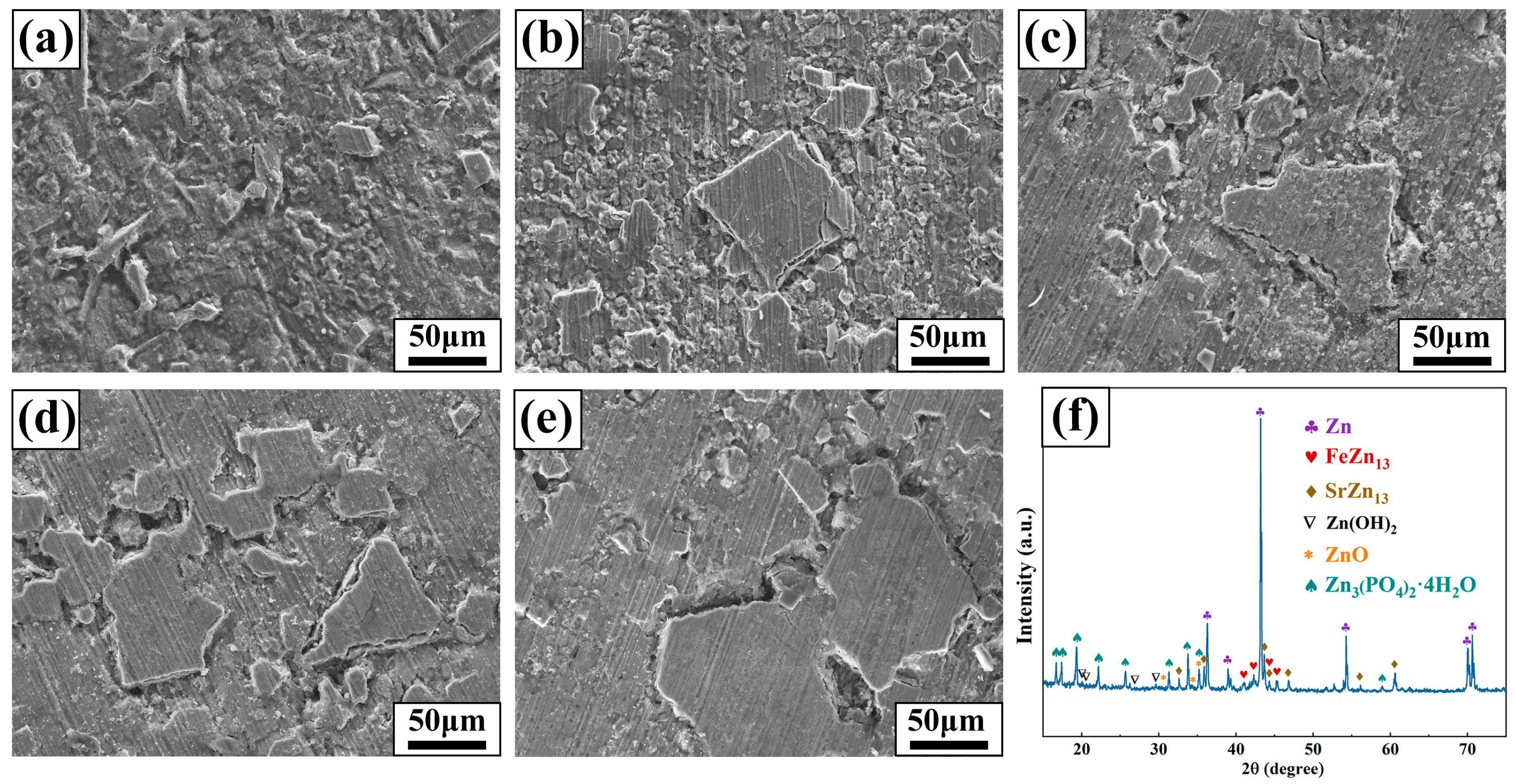

| Alloy | Ecorr/V | icorr/μA·cm−2 | Corrosion Rate/mm·Year−1 |
|---|---|---|---|
| Zn-1Fe | −1.0997 | 3.582 | 0.0536 |
| Zn-1Fe-0.5Sr | −1.1038 | 4.393 | 0.0658 |
| Zn-1Fe-1Sr | −1.1355 | 4.832 | 0.0723 |
| Zn-1Fe-1.5Sr | −1.1461 | 5.108 | 0.0764 |
| Zn-1Fe-2Sr | −1.1729 | 5.596 | 0.0837 |
| Samples | Rs | Rct | Qdl | |
|---|---|---|---|---|
| (Ω·cm2) | (Ω·cm2) | Y0(Ω−1·sn·cm−2) | n | |
| Zn-1Fe | 77.93 | 1413.1 | 7.0 × 10−6 | 0.800 |
| Zn-1Fe-0.5Sr | 76.81 | 785.4 | 8.4 × 10−6 | 0.802 |
| Zn-1Fe-1Sr | 74.71 | 634.3 | 10.9 × 10−6 | 0.725 |
| Zn-1Fe-1.5Sr | 76.15 | 517.1 | 10.7 × 10−6 | 0.723 |
| Zn-1Fe-2Sr | 75.72 | 354.7 | 32.5 × 10−6 | 0.603 |
Disclaimer/Publisher’s Note: The statements, opinions and data contained in all publications are solely those of the individual author(s) and contributor(s) and not of MDPI and/or the editor(s). MDPI and/or the editor(s) disclaim responsibility for any injury to people or property resulting from any ideas, methods, instructions or products referred to in the content. |
© 2024 by the authors. Licensee MDPI, Basel, Switzerland. This article is an open access article distributed under the terms and conditions of the Creative Commons Attribution (CC BY) license (https://creativecommons.org/licenses/by/4.0/).
Share and Cite
Peng, W.; Lu, Z.; Liu, E.; Wu, W.; Yu, S.; Sun, J. Preparation, Mechanical Properties, and Degradation Behavior of Zn-1Fe-xSr Alloys for Biomedical Applications. J. Funct. Biomater. 2024, 15, 289. https://doi.org/10.3390/jfb15100289
Peng W, Lu Z, Liu E, Wu W, Yu S, Sun J. Preparation, Mechanical Properties, and Degradation Behavior of Zn-1Fe-xSr Alloys for Biomedical Applications. Journal of Functional Biomaterials. 2024; 15(10):289. https://doi.org/10.3390/jfb15100289
Chicago/Turabian StylePeng, Wen, Zehang Lu, Enyang Liu, Wenteng Wu, Sirong Yu, and Jie Sun. 2024. "Preparation, Mechanical Properties, and Degradation Behavior of Zn-1Fe-xSr Alloys for Biomedical Applications" Journal of Functional Biomaterials 15, no. 10: 289. https://doi.org/10.3390/jfb15100289
APA StylePeng, W., Lu, Z., Liu, E., Wu, W., Yu, S., & Sun, J. (2024). Preparation, Mechanical Properties, and Degradation Behavior of Zn-1Fe-xSr Alloys for Biomedical Applications. Journal of Functional Biomaterials, 15(10), 289. https://doi.org/10.3390/jfb15100289






